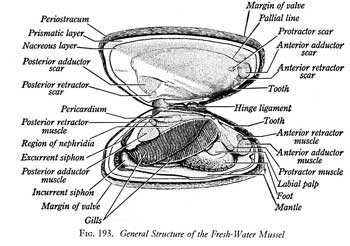|

External anatomy: The mussel's external shell is composed of two valves that protect it from predators and desiccation. Protruding from a valve is an enlarged structure called the umbo, which indicates the dorsal surface of the mussel.

Foot: Like most bivalves, mussels have a large organ referred to as a foot, which is tongue-like in shape with a groove on the ventral surface, which is continuous with the byssus pit. In this pit a viscous secretion is poured out which enters the groove and hardens gradually when it comes into contact with sea water. This forms an extremely tough byssus thread that secures the mussel to its substrate.
Feeding: Both marine and freshwater mussels are filter feeders that feed on plankton. They do so by drawing water in through their incurrent siphon. The water is then brought into the branchial chamber by the actions of the cilia located on the gills for cilliary-mucus feeding. The waste water exits out through the excurrent siphon. The labial palps finally funnel the food into the mouth where digestion can continue.
Clumping: Marine mussels are usually found clumping together on the wave-washed rocks with one another, which anchors them against the force of the waves. Those mussels found in the middle of a clump will have less water loss due to water capture by the other mussels.
Predators: Marine mussels in the wild are eaten by starfish, while living freshwater mussels are a favored source of food for muskrats, otters, raccoons and other mammals.


Outside fertilization: Both marine and freshwater mussels are gonochoristic, with separate male and female individuals. In marine mussels, fertilization occurs outside the body, and there is a larval stage that drifts for a period of from three weeks to six months before settling down on a hard surface as a young mussel. There, it is capable of moving slowly by means of attaching and detaching byssal threads to attain a better life position.
Flushing oxygen-rich water: Freshwater mussels also reproduce sexually. Sperm released by the male directly into the water enters the female via the incurrent siphon. After fertilization, the eggs develop into the larval stage called glochidia. The glochidia grow in the gills of the female where they are constantly flushed with oxygen-rich water. For a time, these glochidia are parasitic on fish, attaching themselves to the fish's fins or gills. They grow and then break free from the host and drop to the bottom of the water. If they land in a place that suits their needs, they will continue their development and begin their independent life.
Freshwater mussel glochidia are generally species-specific and will only live if they find the correct fish host.
Reproduction in the Dreissenidae (zebra mussels and their relatives) is similar to that of the marine mussels.
All text is available under the terms
of the GNU Free Documentation License
|